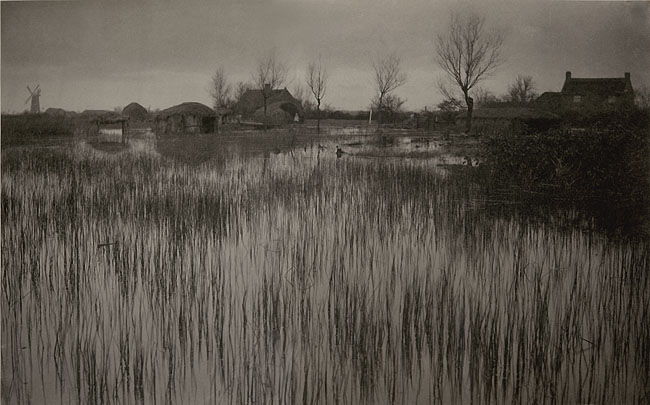Inventing Modernism – P.H. Emerson – “A Rushy Shore” -American Museum of Photography

P.H. Emerson (American, active in England,1856-1936): A Rushy Shore
Platinum print, 7.5 x 11.25 inches/19 x 28.6 cm, 1885/1886
Peter Henry Emerson, trained as a physician and surgeon, gave up medicine and devoted himself to photography and writing — mostly in the marshes and waterways of East Anglia, a rugged region northeast of London. In the 1880s he waged a provocative campaign to have photography recognized as an independent art, and his battles with photography’s old guard included a public feud with Britain’s most popular maker of photographic pictures, Henry Peach Robinson. Dr. Emerson discovered and encouraged a young American photographer named Alfred Stieglitz — like Emerson, a firebrand and an influential organizer whose goal was to modernize photography and gain recognition for the medium’s artistic possibilities. In many ways, Stieglitz continued in the 20th century the revolution that Emerson began at the end of the 19th century.
Emerson decreed that photographers, like other artists, should base their works on observing and interpreting the natural world. He used then-current scientific research on vision to propose that photographs should be relatively sharp only where the most important part of the subject is located, thinking that the eye could only focus most acutely on one area of a scene at a time. The other portions of the photograph were not supposed to be blurry or fuzzy — just less sharp, almost imperceptibly so– in order not to distract the eye from the intended center of attention.
In 1889, Emerson published his theories and advice to amateur photographers in the book Naturalistic Photography for Students of the Art. This work, later described as comparable to ” a bombshell dropped in the midst of a tea-party,” stirred up controversy and interest all over the world. Emerson, however, was not pleased with some of the pictures produced by his would-be followers. Early in 1891, he unleashed another bombshell — a black-bordered pamphlet announcing The Death of Naturalistic Photography, retracting his most important claim — that photography can be Art with a capital “A”. Even so, Emerson continued his own photographic work for decades, and he published a revised third edition of Naturalistic Photography in 1899.
“A Rushy Shore” was one of 40 platinum prints included in Emerson’s limited-edition book, Life and Landscape on the Norfolk Broads (1886). It is arguably the closest Emerson came to the works of the Impressionist painters. The reeds in the foreground dominate the picture; they are carefully aligned with their reflections in the water, doubling their apparent length and adding an element of vertigo to the scene. Emerson’s co-author, the painter T. F. Goodall, makes only passing note of this “curious effect” in the book’s essay on landscapes:
“A Rushy Shore” is a characteristic bit on the margin of one of the Broads. All over the watery foreground grow the small round spears of dark-green rush, reflected with curious effect. In nature this stuff always has a painted look, suggestive of clever execution with large brushes, all the touches vertical, and dragged together while wet. The four graceful little trees are white poplars; many of them grow about here. How beautiful are the branches, softly creeping into the sky! Summer or winter, they are our favourite among all the trees. Look at the marshman getting into his boat, and the figures waiting on the bank. Very quaint are the little boat-shelters, roughly built of logs and reed. The two dwellings are typical of most of the older cottages of the districtred brick, thatched with reed, and very beautifully built. We wish we could say as much for the newer structures unfortunately to be met with in most of the villages.
Goodall was trying to make the case that these “quaint” country buildings were worthy subjects for a painter. Today, though, “A Rushy Shore” seems to be much more than a rustic locale with graceful trees. It is a bold experiment that turns a natural scene into a semi-abstract pattern, and an exploration of the way the viewer’s eye can be manipulated by the photographer’s compositional choices.
Goodall quotation courtesy of David Stone.Copyright © MMIX The American Photography Museum, Inc. All Rights Reserved. “American Museum of Photography” and the logo are Service Marks of The American Photography Museum, Inc.